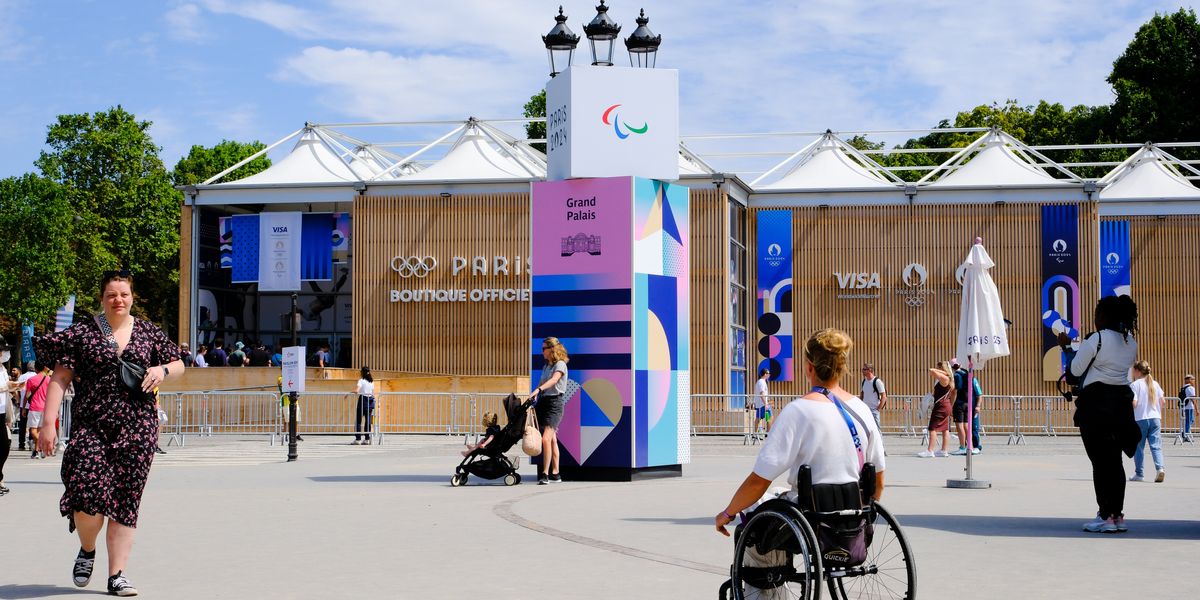A Paris Olympics staff member using a wheelchair was spotted at the official shop in front of the Grand Palais in Paris on July 28. Vincent Koebel/NurPhoto via Getty Images
My husband and I got married in December but decided to keep our trip small and save up for our dream honeymoon. I love visiting new places and trying new things, but traveling as a wheelchair user can be a challenge so I often stick to what I know. From Ireland, where we live, it’s relatively cheap and easy to visit other European countries so I’ve (mostly) stuck with that.
Wanting to break this pattern and get out of my comfort zone, my husband and I decided to go to Japan. Every year, millions of tourists flock to Japan to experience its beautiful scenery and uniquely delicious cuisine. I have the same goal, but I am especially interested in exploring how accessible Japan is to people with mobility aids now.
When Tokyo was chosen to host the 2020 Olympic and Paralympic Games, the organizing committee aimed to make the Games accessible to everyone, regardless of whether they had a disability or not. Not only did they aim to make the sports and venues themselves accessible, but they also aimed to enhance the entire city in this way. It seems like a daunting task, but to some extent it has paid off.
Tokyo’s National Stadium, built specifically for the Olympic and Paralympic Games, is designed with a variety of accessibility features for people with disabilities, and experts hope the stadium’s design will set a new standard for accessible design in Japan.
In addition to building new facilities, Tokyo also worked to improve existing facilities in and around the city. Improvements to the city’s transport network meant providing barrier-free access to some of its major subway and highway stations. According to the Japan National Tourism Organization, these accessibility features remain part of the Tokyo Olympics’ “legacy.”
As preparations begin for this year’s Olympic Games, Paris organizers have risen to the challenge and pledged to increase the city’s accessibility. When announcing the Olympic Accessibility Roadmap, French Prime Minister Elisabeth Borne stressed that “the Olympic and Paralympic Games should be a catalyst for improving the daily lives of people with disabilities.”
Despite these big promises, disability advocates expressed concern and disappointment about what they have seen so far about the efforts to make Paris a more accessible city. When it comes to transport infrastructure, the city seems to have opted for more temporary solutions, such as shuttle buses and taxis for the disabled to take people to their destinations, with no mention of continuing these measures, signaling a disregard for the everyday problems that people with disabilities have getting around the city.
The accessibility of Paris’ public transport is one of the most challenging aspects of getting around the city for me. Despite having visited Paris five times, the Paris metro network remains a total mystery to me. Only one line (line 14) is fully wheelchair accessible, so I often end up taking an expensive taxi when the metro would be a much shorter and cheaper trip. When a wheelchair accessible taxi isn’t available (which is often the case), I have no choice but to traverse cracked pathways and hilly roads in my wheelchair.
Other cities with underground transit systems are similar: in London, only 92 of 272 Tube stations have step-free access, and less than 30% of New York’s Tube stations are fully accessible.
For me, next to navigating public transport, I think the hardest part about traveling to a new place is finding suitable accommodation – it’s like looking for a needle in a haystack.
Ahead of the Paris Olympics, French hotel group Accor has made efforts to make its hotels more accessible to people with various disabilities. As Anne-Sophie Belleau, Accor’s senior vice president of group diversity, inclusion and social care, told The Huffington Post in a piece I wrote about earlier this year, these efforts “not only establish a tradition of inclusion, but also promote the adoption of these best practices globally.”
And earlier this week, Airbnb, a global partner of the Olympic and Paralympic Games, announced that 1,000 accommodations in the Paris area have step-free accessibility features on its platform. Hopefully, this renewed interest in accessibility and inclusivity won’t fade once the Olympics are over. Disabled Parisians and tourists alike will continue to need accessible transport and step-free accommodations.
The new, accessible infrastructure in Japan and Paris will benefit the cities long after the Olympics and Paralympics are over, but unfortunately some accessibility issues, such as the Paris subway, will remain.
And yet, despite the many accessibility barriers I face, I love Paris. It’s where my husband proposed to me, and I have sentimental reasons to hope that the Olympics will be a catalyst for improved accessibility. Instead of implementing temporary accessibility measures for a large, one-off event, all cities can and should work steadily toward a society in which people with disabilities can fully participate. The cities we love will one day love us back.


